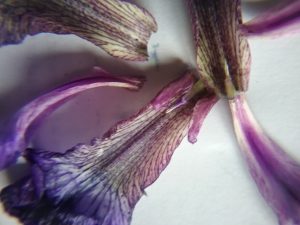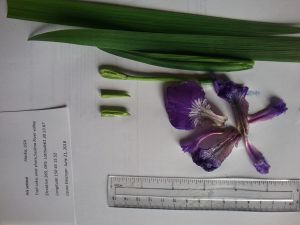We have had rain every day for weeks so my sample is staining the paper. Good for berries but sad for flowers and veggies. Attached are three photos of iris growing along our lake front. The ovary appears to have three open carpel compartments, with axial placentation. The eggs line up like seeds in a pepper. If you look closely at the base of the petals, you can see two of the three stamens. I saw no styles in two specimens I cut open.
Steffi, is there a trick to pressing fleshy plant parts and juicy stems? 




Thanks Laura,
these look good. In regards to your question about fleshy parts, you will have to squash them, and then make sure to change the paper often so that you do not get mold forming. Sometimes for aquatic plants we use wax paper on one side, since they will otherwise not come off from the newspaper easily after they have been pressed. I think I showed in the pressing plants video that we use a special blotter paper, https://herbariumsupply.com/product/heavy-white-driers-blotting/
it helps wicks away moisture, and can be reused many times. The flowers of Iris are a bit tricky. Each stigma is directly above a sepal. The petal stands upright in the alternate position. The stigma’s pollen receptive surface is a small flap of tissue located on the side of the stigma that is pressed against the adjacent sepal. Between each sepal-stigma combination is a stamen. A nectar-gathering insect must push the stigma and sepal apart to get to the nectary or stamen. A little bit of an unusual flower, sometimes the cultivated varieties are even more complex with additional whorls of tepals.
This is great, thanks! My husband just recorded a bee getting in and out of an Iris to get nectar, in slow motion, and it looks like quite the endeavor! I uploaded his little IPhone video here:
https://www.youtube.com/watch?v=Z1A8fAnAd9k